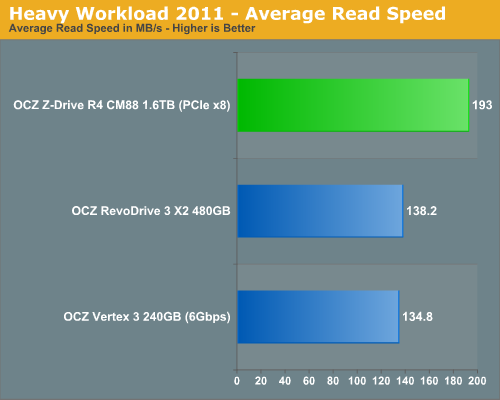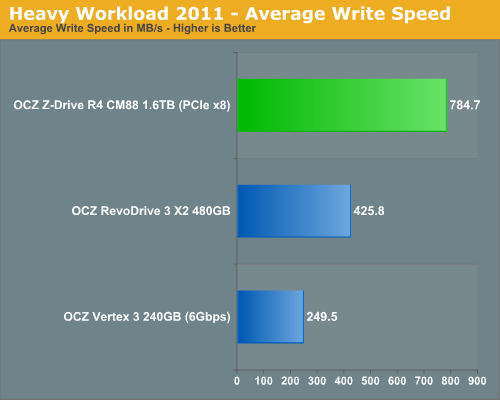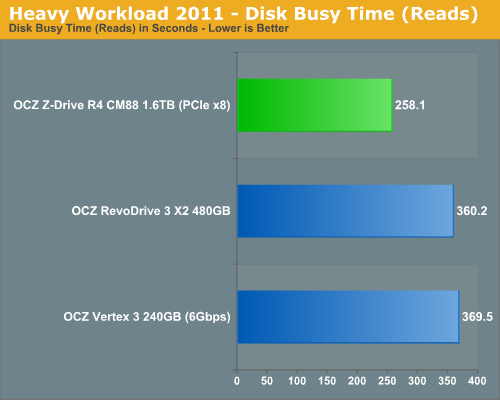OCZ Z-Drive R4 CM88 (1.6TB PCIe SSD) Review
by Anand Lal Shimpi on September 27, 2011 2:02 PM EST- Posted in
- Storage
- SSDs
- OCZ
- Z-Drive R4
- PCIe SSD
AnandTech Storage Bench 2011
Last year we introduced our AnandTech Storage Bench, a suite of benchmarks that took traces of real OS/application usage and played them back in a repeatable manner. I assembled the traces myself out of frustration with the majority of what we have today in terms of SSD benchmarks.
Although the AnandTech Storage Bench tests did a good job of characterizing SSD performance, they weren't stressful enough. All of the tests performed less than 10GB of reads/writes and typically involved only 4GB of writes specifically. That's not even enough exceed the spare area on most SSDs. Most canned SSD benchmarks don't even come close to writing a single gigabyte of data, but that doesn't mean that simply writing 4GB is acceptable.
Originally I kept the benchmarks short enough that they wouldn't be a burden to run (~30 minutes) but long enough that they were representative of what a power user might do with their system.
Not too long ago I tweeted that I had created what I referred to as the Mother of All SSD Benchmarks (MOASB). Rather than only writing 4GB of data to the drive, this benchmark writes 106.32GB. It's the load you'd put on a drive after nearly two weeks of constant usage. And it takes a *long* time to run.
1) The MOASB, officially called AnandTech Storage Bench 2011 - Heavy Workload, mainly focuses on the times when your I/O activity is the highest. There is a lot of downloading and application installing that happens during the course of this test. My thinking was that it's during application installs, file copies, downloading and multitasking with all of this that you can really notice performance differences between drives.
2) I tried to cover as many bases as possible with the software I incorporated into this test. There's a lot of photo editing in Photoshop, HTML editing in Dreamweaver, web browsing, game playing/level loading (Starcraft II & WoW are both a part of the test) as well as general use stuff (application installing, virus scanning). I included a large amount of email downloading, document creation and editing as well. To top it all off I even use Visual Studio 2008 to build Chromium during the test.
The test has 2,168,893 read operations and 1,783,447 write operations. The IO breakdown is as follows:
| AnandTech Storage Bench 2011 - Heavy Workload IO Breakdown | ||||
| IO Size | % of Total | |||
| 4KB | 28% | |||
| 16KB | 10% | |||
| 32KB | 10% | |||
| 64KB | 4% | |||
Only 42% of all operations are sequential, the rest range from pseudo to fully random (with most falling in the pseudo-random category). Average queue depth is 4.625 IOs, with 59% of operations taking place in an IO queue of 1.
Many of you have asked for a better way to really characterize performance. Simply looking at IOPS doesn't really say much. As a result I'm going to be presenting Storage Bench 2011 data in a slightly different way. We'll have performance represented as Average MB/s, with higher numbers being better. At the same time I'll be reporting how long the SSD was busy while running this test. These disk busy graphs will show you exactly how much time was shaved off by using a faster drive vs. a slower one during the course of this test. Finally, I will also break out performance into reads, writes and combined. The reason I do this is to help balance out the fact that this test is unusually write intensive, which can often hide the benefits of a drive with good read performance.
There's also a new light workload for 2011. This is a far more reasonable, typical every day use case benchmark. Lots of web browsing, photo editing (but with a greater focus on photo consumption), video playback as well as some application installs and gaming. This test isn't nearly as write intensive as the MOASB but it's still multiple times more write intensive than what we were running last year.
As always I don't believe that these two benchmarks alone are enough to characterize the performance of a drive, but hopefully along with the rest of our tests they will help provide a better idea.
The testbed for Storage Bench 2011 has changed as well. We're now using a Sandy Bridge platform with full 6Gbps support for these tests. All of the older tests are still run on our X58 platform.
AnandTech Storage Bench 2011 - Heavy Workload
We'll start out by looking at average data rate throughout our new heavy workload test:

I don't expect many desktop/workstation users to buy Z-Drive R4s, but this is the fastest SSD we've tested in our AnandTech Storage Bench 2011 suite. Note the imperfect scaling from 4 to 8 controllers however, the increase over the RevoDrive 3 X2 is only 56%. Even with a strenuous desktop workload it's tough to fully load all 8 controllers in the Z-Drive R4.


The next three charts just represent the same data, but in a different manner. Instead of looking at average data rate, we're looking at how long the disk was busy for during this entire test. Note that disk busy time excludes any and all idles, this is just how long the SSD was busy doing something:













57 Comments
View All Comments
squashmeister99 - Tuesday, September 27, 2011 - link
You teased us with your video reviews. Now we cant go back... :-)G-Man - Tuesday, September 27, 2011 - link
I miss the video reviews already :-)vol7ron - Tuesday, September 27, 2011 - link
hahaha. they are a good addition aren't they?Rasterman - Wednesday, September 28, 2011 - link
Comparing a single Vertex 3 240GB to a 1.6TB doesn't seem quite valid. Someone considering the R4 would be asking what is the performance difference between the R4 and 4 to 16 Vertex 3s in RAID 0. Especially considering the massive cost savings per GB using the Vertex 3s.MrBungle123 - Wednesday, September 28, 2011 - link
I'd like to see some RAID 5/6/10 arrays of 15K RPM SCSI drives in the benchmarks too.marraco - Wednesday, September 28, 2011 - link
No. I don't want video reviews, unless they have English subtitles.SilthDraeth - Wednesday, September 28, 2011 - link
I have trouble hearing and use subs for all my movies, yet Anand speaks quite clearly, and I have no trouble understanding him.Also, he posts the video review in conjunction with the written review, and not as a stand alone feature, so you really don't need it subtitled. So you would still get to enjoy the reviews as you always have.
Lonbjerg - Thursday, September 29, 2011 - link
You can write english but not understand it when it's spoken? *shakes head*connor4312 - Thursday, September 29, 2011 - link
I'm guessing you never learned a second language?arthur449 - Wednesday, September 28, 2011 - link
Not all information provided is specifically relevant to everyone's interests in a review of a product. Similarly, information provided in a video review follows a linear arbitrary organizational structure that cannot possibly align with everyone's preferred method of learning. Also, it's easier to skim / search / quote / share a text-based review.